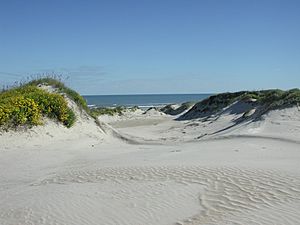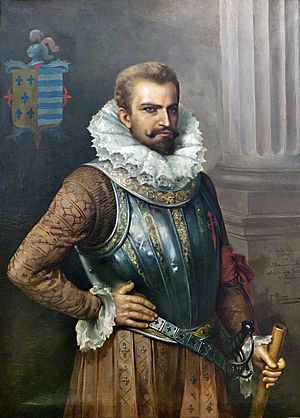Ángel de Villafañe facts for kids
Ángel de Villafañe (born around 1504) was a Spanish conquistador, which means he was an explorer and soldier who helped Spain take control of new lands. He explored parts of Florida, Mexico, and Guatemala. He was also an explorer, led expeditions, and was a ship captain for Hernán Cortés. Villafañe was involved in many Spanish settlements and helped with shipwrecks along the Gulf of Mexico in the 1500s.
Contents
Early Life and Adventures
Ángel de Villafañe was born about 1504. His parents, Juan de Villafañe and Catalina de Valdés, were from León, Castile in Spain. They had served the Spanish rulers Ferdinand and Isabella. When he was just nine years old, in 1513, young Angel traveled with his father to Darién (a region in modern-day Panama) as part of a fleet led by Pedrarias Dávila.
In 1523, Villafañe went to Pánuco, Mexico, with Francisco de Garay. When Garay's plans to start a colony were stopped by Hernán Cortés, Villafañe decided to join Cortés's group and sailed to Mexico City.
In Mexico City, Ángel de Villafañe married Doña Ynés de Caravajal. She was a relative of Pedro de Alvarado, another famous conquistador who was second-in-command to Hernán Cortés and later governor of Guatemala. Villafañe became known as an important gentleman in Mexico City. Both he and his wife were respected as "gentle people, hidalgos (a type of Spanish nobility), and very wealthy."
Villafañe took part in the conquest of Michoacán and Colima in Mexico. He also helped to bring the Chontal Mayas, the Zapotecs, and the Mixes under Spanish control. For his actions, he was given an encomienda at Xaltepec. An encomienda was a system where Spanish settlers were given control over groups of native people and their land. He then helped to bring peace to Jalisco and, as a ship captain, joined Cortés's exploration of the Pacific coast.
Shipwrecks and Rescue Missions
In 1553, Villafañe got caught in a political disagreement. He had followed orders from the viceroy (a powerful official who ruled the colony for the king) to arrest a royal inspector. Caught between the viceroy and the royal audiencia (a high court and governing body), he tried to get out of trouble by sending a letter to the Holy Roman Emperor Charles I of Spain.

His letter was sent in April 1554 on the ship San Andrés. This was the only ship out of four that made it safely to port. The other three ships were destroyed by a hurricane along the coast of Padre Island, in what is now Texas. In early June, when news of this disaster reached Mexico City, the viceroy asked for a rescue fleet. He immediately sent Villafañe overland to find the ships, which were full of treasure.
Villafañe traveled to Pánuco and hired a ship to take him to the shipwreck site. He arrived in time to meet García de Escalante Alvarado (a nephew of Pedro de Alvarado), who was leading the effort to save items from the wrecks. Alvarado arrived by sea on July 22, 1554. The team worked until September 12 to salvage the treasure from Padre Island.
This loss, along with other ship disasters around the Gulf of Mexico, led to a plan. The Spanish wanted to build a settlement on the northern Gulf Coast. This would help protect shipping and allow them to rescue shipwreck survivors more quickly. Because of this, the expedition of Tristán de Luna y Arellano was sent. They landed at Pensacola Bay on August 15, 1559.
Leading Expeditions in Florida
Ángel de Villafañe was involved in the Luna expedition from the very beginning. Before the ships sailed, he was in charge of the camp at Jalapa, while Luna went to Veracruz to finish preparing for the trip. Later, Villafañe commanded the San Juan de Ulúa military base at Veracruz. This allowed him to keep an eye on the operation and report back to the viceroy, Luis de Velasco.
More than a year later, Luna was struggling to manage the settlements in Florida and Santa Elena. So, Viceroy Velasco sent Villafañe to take his place. Tristán de Luna y Arellano had become ill trying to move the Ochuse settlement, which had been badly damaged by a hurricane in September 1559. Most of the local food, like corn, beans, and pumpkins, was also gone.
Villafañe reached the Ochuse (Pensacola) settlement in early March 1561. On April 9, he took over as governor of both "provinces of La Florida and Punta de Santa Elena" from Luna.
Leaving 50 men at Ochuse, Villafañe sailed the rest of the colony (about 230 people) to Santa Elena (Georgia near South Carolina). After several landings along the Carolina coast, while looking for a good port, the fleet was hit by another hurricane. However, some ships managed to survive.
Villafañe sailed his storm-damaged fleet to Hispaniola and then to Havana, Cuba. There, many of his soldiers left. After three months in Cuba, Villafañe returned to Ochuse (Pensacola Bay) to pick up the remaining 50 men of the colony. He then sailed back to Mexico.
Along with others who had been part of the Florida and Santa Elena attempts, Villafañe was called by Viceroy Velasco to give advice on future settlements. The people meeting decided that new settlements on both the Gulf Coast and the Atlantic coast were not a good idea at that time. Future efforts on the Atlantic coast would be made from Spain. No new Spanish colonies were started on the northern Gulf shore until more than a century later, after René Robert Cavelier, Sieur de La Salle, landed in Texas.
Records of Villafañe's death have not been found.
See also
 In Spanish: Ángel de Villafañe para niños
In Spanish: Ángel de Villafañe para niños




